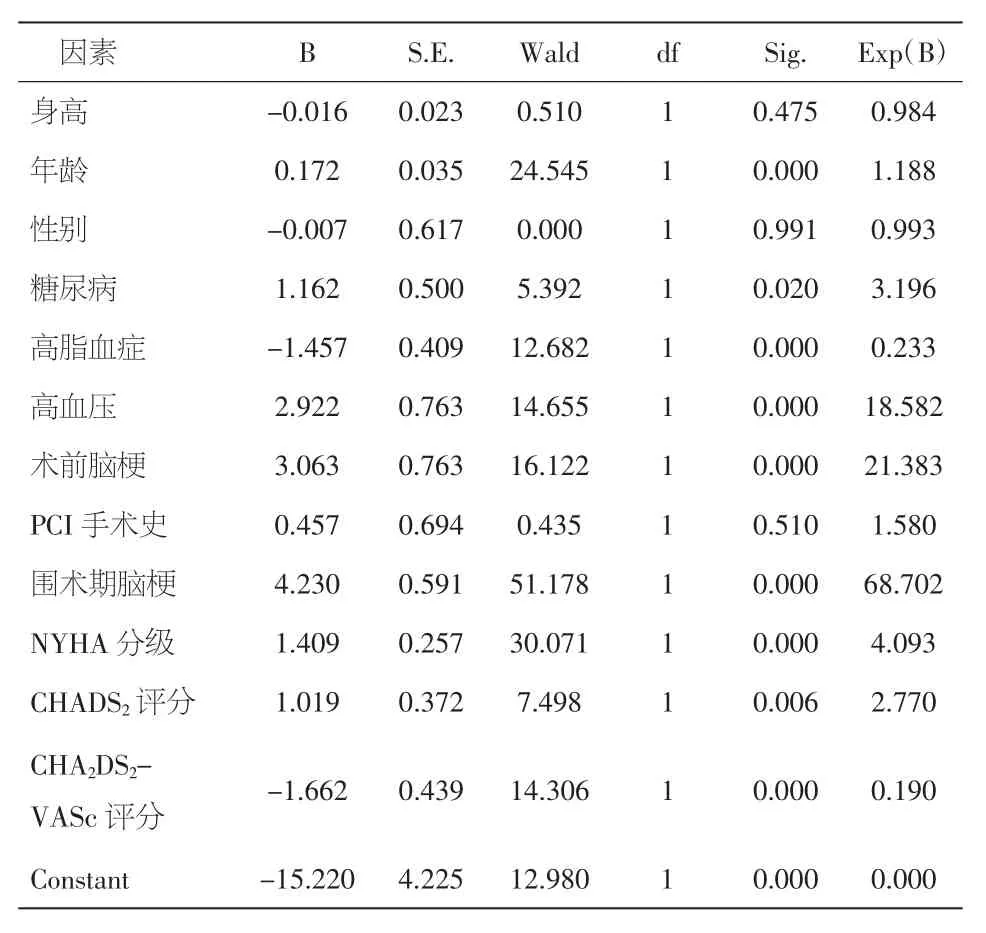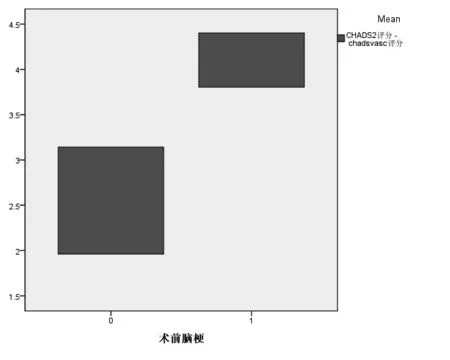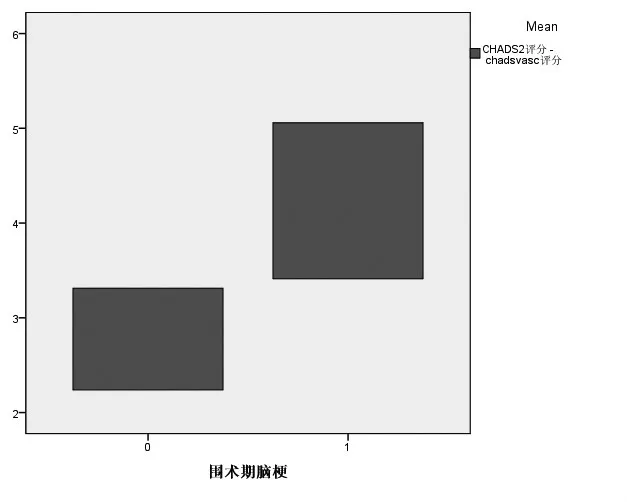CHADS2及CHA2DS2-VASc评分在冠心病外科治疗中的应用
2015-09-15王颍骅薛松
王颍骅 薛松
临床研究
CHADS2及CHA2DS2-VASc评分在冠心病外科治疗中的应用
王颍骅 薛松
作者单位:200127 上海市,上海交通大学医学院附属仁济医院心血管外科
目的 评价CHADS22及CHA2DS2-VASc评分系统在冠心病外科治疗中的意义。方法 选择2006年1月至2010年1月行不停跳冠状动脉旁路移植术的768例患者,术后新发房颤患者97例。回顾患者的围术期及随访资料,应用CHADS2及CHA2DS2-VASc评分系统进行分析。结果 768例患者术后新发房颤发生率12.6%,分为术后新发房颤组与非房颤组。新发房颤组与非房颤组平均年龄分别为(70.74±8.21)岁和(65.90±9.83)岁,围术期脑卒中分别为8例和9例,CHADS2评分值分别为3.20±1.26和2.13±0.94,CHA2DS2-VASc评分值分别为4.20±1.50和3.23±1.07。CHADS2和CHA2DS2-VASc评分是术后新发房颤的预测因素,与围术期脑卒中显著相关(P<0.01)。结论 冠心病外科治疗中应用CHADS2及CHA2DS2-VASc评分系统可预测术后新发房颤及围术期脑卒中,对冠心病术后新发房颤的抗凝及抗血小板治疗决策提供了依据,对卒中风险及预后有一定的评估价值。
CHADS2和CHA2DS2-VASc评分; 冠状动脉旁路移植术; 术后新发房颤; 脑卒中
房颤和冠心病都是常见病,据统计,65岁以上人群的房颤发生率为3%~5%。冠心病外科治疗围术期常出现房颤和缺血性脑卒中,但是冠状动脉旁路移植术后抗凝和抗血小板治疗方案仍存在争议。2010年欧洲公布新房颤指南后,对于非瓣膜性房颤出现了两个评分系统,分别为CHADS2及CHA2DS2-VASc评分系统。本研究应用上述两个评分系统对不停跳冠状动脉旁路移植的病例进行了回顾性分析,现总结如下。
1 资料与方法
1.1 临床资料 选择2006年1月至2010年1月上海交通大学医学院附属仁济医院心血管外科收治的768例不停跳冠状动脉旁路移植手术患者,其中97例术后新发房颤,分为术后新发房颤组与非房颤组。回顾患者的围术期资料,应用CHADS2及CHA2DS2-VASc评分系统进行分析,一般资料见表1。
表1 术后新发房颤组与非房颤组的围术期资料比较(±s)

表1 术后新发房颤组与非房颤组的围术期资料比较(±s)
组别 例数 男/女 年龄(岁) 糖尿病 高脂血症 高血压 术前脑梗 术前PCI史 围术期脑梗术后新发房颤组 97 11/86 70.74±8.21 58 20 91 39 38 8非房颤组 671 328/343 65.90±9.83 486 202 517 88 42 9 P值 <0.01 <0.05 <0.05 NS <0.01 <0.01 <0.01 <0.01组别 NYHA心功能分级 搭桥数量 术后3 d肌酐(μmol/L)CHA2DS2-VASc评分Ⅰ级 Ⅱ级 Ⅲ级 Ⅳ级CHADS2评分术后新发房颤组 7 54 24 12 3.53±0.64 94.12±45.81 3.20±1.26 4.20±1.50非房颤组 315 255 97 4 3.32±0.52 89.66±39.41 2.13±0.94 3.23±1.07 P值 <0.01 NS NS <0.01 <0.01
1.2 方法 将768例患者分为术后新发房颤组与非房颤组,回顾患者的围术期资料,计算CHADS2及CHA2DS2-VASc值,进行对照研究。
1.3 统计学方法 应用SPSS 16.0进行统计分析。应用t检验、卡方、Logistic多因素回归分析对计量资料和计数资料进行分析。P<0.05为差异有统计学意义。
2 结果
术后新发房颤组与非房颤组的CHADS2评分值 分别 为 3.20±1.26 和 2.13±0.94(P<0.01),CHA2DS2-VASc评分值分别为4.20±1.50和3.23±1.07(P<0.01)。多因素分析表明,术后新发房颤与CHADS2、CHA2DS2-VASc评分和评分内重要评分指标均显著相关,如表2所示。术前脑梗患者的CHADS2及CHA2DS2-VASc评分均值明显高于无术前脑梗患者(P<0.01),见图1。围术期脑梗患者的CHADS2及CHA2DS2-VASc评分均值也显著高于无围术期脑梗患者(P<0.01),见图2。

表2 术后新发房颤的多因素回归分析

图1 术前脑梗与CHADS2及CHA2DS2-VASc评分的比较
3 讨论
中国冠心病及房颤的发病率逐年上升,超过65岁的人群中有3%~5%发生房颤。房颤不仅影响心脏有效射血量,也是血栓栓塞尤其是脑卒中的重要原因。80%的中风源于房颤后心脏血栓,抗凝治疗可以使房颤后发生卒中的风险降低64%[1],因此有效抗凝预防血栓栓塞越来越受到重视。

图2 围术期脑卒中与CHADS2及CHA2DS2-VASc评分的比较
术后新发房颤是一种常见的心脏术后并发症,在冠状动脉搭桥术后的发生率为11%~40%,是心脏术后总死亡率及晚期死亡率的独立相关因素[2-8]。有报道,心脏术后新发房颤与心脏基础疾患、心肌保护不良、年龄、左房重构、代谢综合征、自主神经及内分泌系统改变、炎症反应和氧化应激相关[9]。术后新发房颤是影响冠状动脉搭桥术后精神及体力的独立因素,不但与近期并发症相关,而且是影响术后长期生存的负性因素[2,7,10,11]。由于新发房颤及脑卒中对冠状动脉旁路移植术后功能恢复及预后有重大影响,因此,早期发现房颤及脑卒中高危人群,早期预测围术期脑卒中的风险,严格执行推荐的抗凝指导策略,对降低围术期脑卒中,降低冠状动脉旁路移植术后死亡率有极其重要的作用。
鉴于房颤的华法林抗凝治疗的出血风险,冠状动脉旁路移植术后合并房颤的抗凝及抗血小板聚集治疗方案选择一直存在争议。CHADS2和CHA2DS2-VASc评分是欧洲心脏病学会及2012房颤指南推荐的评估非瓣膜性房颤卒中风险及指导抗凝策略的评分系统,使用CHADS2及CHA2DS2-VASc评分能够预测心脏术后新发房颤及脑卒中,对高危患者的判定非常准确[12]。CHADS2评分系统包含5项评分标准:充血性心力衰竭、高血压、年龄≥75岁、糖尿病、中风或短暂脑缺血发作(TIA),<2分为低危人群需要阿司匹林抗凝,≥2分为中高危人群需要华法林抗凝控制INR(国际标准比值)至2~3。CHA2DS2-VASc评分标准较CHADS2评分增加了3个项目,分别为性别、年龄<60岁和外周血管疾病。CHADS2及CHA2DS2-VASc评分系统均为预测非瓣膜性房颤患者脑卒中风险的体系,但其评价意义不同。CHADS2评分系统注重于非瓣膜性房颤卒中风险的高危人群,而CHA2DS2-VASc评分系统对筛选低危人群更敏感[13]。CHADS2及CHA2DS2-VASc评分可以预测非瓣膜性房颤的中风风险和中长期预后;能够评估急性冠脉综合征后新发房颤及死亡、心梗、中风等不良并发症的风险,生存曲线表明,≥2分的相关并发症明显增多;还能预测无房颤冠心病的潜在房颤和中风风险,对指导围术期胺碘酮、β受体抑制剂、他汀类药物干预房颤有意义,能够使高危人群获益[14-19]。有报道,CHADS2及CHA2DS2-VASc评分与房颤患者的左房重构、慢性充血性心衰、高炎症反应明显相关[20-22]。此外,上述结果与BNP(心房尿钠肽)预测房颤患者心血管事件结果相一致,因而,可以评估长期预后[23]。大量文献及荟萃分析表明,CHADS2评分是评价高危人群指导抗凝的有效评价标准,而CHA2DS2-VASc评分在评估低危人群的中风风险中较CHADS2评分更具有优势,CHADS2评分≥2分需要正规华法林抗凝治疗[24-28]。
本研究对行不停跳冠状动脉旁路移植的患者进行了CHADS2及CHA2DS2-VASc评分,结果发现术后新发房颤患者的术前CHADS2及CHA2DS2-VASc评分值明显高于无房颤患者,且术前脑梗及围术期脑梗患者评分均值明显高于非脑梗患者(P<0.01),提示 CHADS2和 CHA2DS2-VASc评分系统能够有效预测术后新发房颤及脑卒中,指导围术期抗凝及抗血小板治疗,减少冠状动脉旁路移植术后房颤引起的并发症。
综上所述,CHADS2及CHA2DS2-VASc评分系统能够预测术后新发房颤,对早期发现围术期脑卒中高危人群、指导抗凝及抗血小板治疗策略、降低围术期脑卒中、降低冠状动脉搭桥术后死亡率、提高远期生存率和生活质量有重要意义。
[1]刘骅,刘启明.CHADS2评分与CHA2DS2-VASC评分孰优孰劣.中外医疗,2014,6:196-198.
[2]Ivanovic B,Tadic M,Bradic Z,et al.The influence of the metabolic syndrome on atrial fibrillation occurrence and outcome after coronary bypass surgery:a 3-year follow-up study.Thorac Cardiovasc Surg,2014,62:561-568.
[3]Bramer S,van Straten AHM,Hamad MAS,et al.The impact of new-onset postoperative atrial fibrillation on mortality after coronary artery bypass grafting.Ann Thorac Surg,2010,90:443-450.
[4]Shingu Y,Kubota S,Wakasa S,et al.Postoperative atrial fibrillation:mechanism,prevention and future perspective.Surg To-day,2012,42:819-824.
[5]Hernandez AV,Kaw R,Pasupuleti V,et al.Association between obesity and postoperative atrial fibrillation in patients undergoing cardiac operations:a systematic review and meta-analysis.Ann Thorac Surg,2013,96:1104-1116.
[6]Narducci ML,Pelargonio G,Rio T,et al.Predictors of postoperative atrial fibrillation in patients with coronary artery disease undergoing cardiopulmonary bypass:a possible role for myocardial ischemia and atrial inflammation.Journal of Cardiothoracic and Vascular Anesthesia,2014,28:512-519.
[7]Al-Shaar L,Schwann TA,Kabour A,et al.Increased late mortality after coronary artery bypass surgery complicated by isolated new-onsetatrialfibrillation:A comprehensive propensitymatched analysis.J Thorac Cardiovasc Surg,2014,148:1860-1868.
[8]Lee SH,Kang DR,Uhm JS,et al.New-onset atrial fibrillation predicts long-term newly developed atrial fibrillation after coronary artery bypass graft.Am Heart J,2014,167:593-600.
[9]Bramer S,ter Woorst FJ,van Geldorp MWA,et al.Does newonset postoperative atrial fibrillation after coronary artery bypass grafting affect postoperative quality of life?J Thorac Cardiovasc Surg,2013,146:114-118.
[10]Saxena A, Dinh DT, Smith JA, etal.Usefulnessof postoperative atrial fibrillation as an independent predictor for worse early and late outcomes after isolated coronary artery bypass grafting (Multicenter Australian Study of 19497 patients).Am J Cardiol,2012,109:219-225.
[11]Thoren E,Hellgren L,Granath F,et al.Postoperative atrial fibrillation predicts cause-specific late mortality after coronary surgery.Scandinavian Cardiovascular Journal,2014,48:71-78.
[12]Chua SK,Shyu KG,Lu MJ,et al.Clinical utility of CHADS2and CHA2DS2-VASc scoring systems for predicting postoperative atrial fibrillation after cardiac surgery.J Thorac Cardiovasc Surg,2013,146:919-926.
[13]Chua SK,Lo HM,Chiu CZ,et al.Use of CHADS2and CHA2DS2-VASc scores to predictsubsequentmyocardial infarction,stroke,and death in patients with acute coronary syndrome:data from Taiwan acute coronary syndrome full spectrum registry.PLoS ONE,2014,9:e111167.
[14]Svendsen JH,Nielsen JC,Darkner S,et al.CHADS2and CHA2DS2-VASc score to assess risk of stroke and death in patients paced for sick sinus syndrome.Heart,2013,99:843-848.
[15]Kim D,Chung JW,Kim CK,et al.Impact of CHADS2score on neurological severity and long-term outcome in atrial fibrillationrelated ischemic stroke.J Clin Neurol,2012,8:251-258.
[16]Welles CC,Whooley MA,Na B,et al.The CHADS2score predicts ischemic stroke in the absence of atrial fibrillation among patients with coronary heart disease:data from the heart and soul Study.Am Heart J,2011,162:555-561.
[17]Philip I,Berroeta C,Leblanc I.Perioperative challenges of atrial fibrillation.Curr Opin Anesthesiol,2014,27:344-352.
[18]Huang SS,Chan WL,Leu HB,et al.Association between CHADS2score and the preventive effect of statin therapy on new-onset atrial fibrillation in patients with acute myocardial infarction.PLoS ONE,2013,8:e74709.
[19]Chatterjee S,Sardar P,Mukherjee D,et al.Timing and route of amiodarone for prevention of postoperative atrial fibrillation after cardiac surgery:a network regression meta-analysis.PACE,2013,36:1017-1023.
[20]Li YH,Ding WY,Wang H,et al.Relationship of CHA2DS2-VASc and CHADS2score to left atrial remodeling detected by velocity vector imaging in patients with atrial fibrillation.PLoS ONE,2013,8:e77653.
[21]Decker JM,Madder RD,Hickman L,et al.CHADS2score is predictive of left atrial thrombus on precardioversion transesophageal echocardiography in atrial fibrillation.Am J Cardiovasc Dis,2011,1:159-165.
[22]Hung CY,Hsieh YC,Huang JL,et al.Statin therapy for primary prevention of atrial fibrillation:Guided by CHADS2/CHA2DS2-VASc Score.Korean Circ J,2014,44:205-209.
[23]Nakamura M,Koeda Y,Tanaka F,et al.Plasma B-type natriuretic peptide as a predictor of cardiovascular events in subjects with atrial fibrillation:a community-based study.PLoS ONE,2013,8:e81243.
[24]Chen JY,Zhang AD,Lu HY,et al.CHADS2versus CHA2DS2-VASc score in assessing the stroke and thromboembolism risk stratification in patients with atrial fibrillation:a systematic review and meta-analysis.Journal of Geriatric Cardiology,2013,10:258-266.
[25]Winkle RA,Mead RH,Engel G,et al.Comparison of CHADS2and CHA2DS2-VASC anticoagulation recommendations:evaluation in a cohort of atrial fibrillation ablation patients.Europace,2014,16:195-201.
[26]Oh S,Kim SJ,Ryu SK,et al.The determinants of stroke phenotypes were different from the predictors(CHADS2and CHA2DS2-VASc) of stroke in patients with atrial fibrillation:a comprehensive approach.BMC Neurology,2011,11:107-114.
[27]Sareh S,Toppen W,Mukdad L,et al.CHADS2score predicts atrialfibrillation following cardiac surgery.J Surg Res,2014,190:407-412.
[28]Potpara TS,Polovina MM,Djikic D,et al.The association of CHA2DS2-VASc score and blood biomarkers with ischemic stroke outcomes:the belgrade sroke study.PLoS ONE,2014,9:e106439.
The application of CHADS2and CHA2DS2-VASc score in coronary artery bypass surgery
The application of CHADS2and CHA2DS2-VASc score in coronary artery bypass surgery
WANG Ying-hua,XUE Song.Department of Cardiovascular Surgery,Renji Hospital,School of Medicine,Shanghai Jiao Tong University,Shanghai 200127,China
XUE Song,E-mail:xuesong64@163.com
ObjectiveThe purpose of this study is to evaluate CHADS2and CHA2DS2-VASc score in coronary artery bypass surgery.MethodsClinical records of 768 patients who underwent off pump coronary artery bypass grafting surgery were analyzed retrospectively.CHADS2and CHA2DS2-VASc score have been used in the analysis.ResultsThe patients were divided into two groups:postoperative atrial fibrillation group and non-atrial fibrillation group.The incidence of postoperative atrial fibrillation was 12.6%.The average age was (70.74±8.21)years old and (65.90±9.83)years old,the number of postoperative stroke was 8 and 9,CHADS2score was 3.20±1.26 and 2.13±0.94,CHA2DS2-VASc score was 4.20±1.50 and 3.23±1.07 respectively.CHADS2and CHA2DS2-VASc scoring were predictors of postoperative atrial fibrillation and were closely associated with perioperaive stroke(P<0.01).ConclusionOur results suggest that CHADS2and CHA2DS2-VASc score are highly reliable in the prediction of postoperative atrial fibrillation as well as perioperative stroke.Therefore,the scoring system is valuable in anticoagulation and antiplatelet management and prophylactic consideration in coronary artery bypass surgery for atrial fibrillation and stroke.Hence,CHADS2and CHA2DS2-VASc score system is applicable in clinical practice of coronary artery bypass surgery.
CHADS2and CHA2DS2-VASc score; Coronary artery bypass grafting surgery; Postoperative atrial fibrillation;Stroke
薛松,E-mail:xuesong64@163.com
10.3969/j.issn.1672-5301.2015.04.007
R654.2
A
1672-5301(2015)04-0316-04
2015-01-19)
